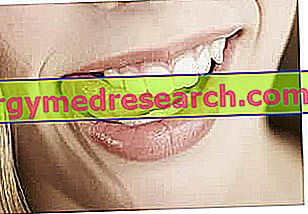Chipped teeth: causes
Chipped teeth recognize the main causative agent in accidental falls to the ground. Similarly, a tooth can be chipped by munching on crunchy and hard foods like nuts, nougat, ice or whatever.

Just like children, the elderly also run a higher risk of chipping a tooth. During senescence, the teeth become more fragile, therefore subject to breakage. For this reason, the teeth of the elderly can chip more easily by chewing a crunchy or too hard food.
Last but not least, the impact produced by violent accidents in cars, motorcycles or bicycles can damage and chip even the healthiest teeth, regardless of the age of the victim.
Symptoms and consequences
In addition to ruining the harmony of the smile, a chipped tooth can be a source of embarrassment and shame in social relationships (especially if the damaged tooth - as often happens - is really an incisor). Not to mention, then, the pain and the (possible) shock that can arise from a trauma to the mouth. In many subjects, the vision (and awareness) of a chipped tooth in the mouth can cause a collapse of self-esteem.
Fortunately, modern cosmetic dentistry can remedy dental damage, correcting or perfectly masking the chipping: in this way, the lesion suffered by the tooth is made almost invisible.
Clearly, when the chipped tooth is a milk tooth, it is not necessary to resort to a dental-aesthetic intervention because this will spontaneously fall to be subsequently replaced by a permanent tooth.
What to do
The first caution to do when splintering a tooth is to put ice outside the mouth (in correspondence with the damage suffered). Cryotherapy (cold therapy) is in fact a useful remedy to reduce toothache and reduce swelling. If possible, wrap the ice in a soft cloth to avoid cold burns.
As soon as possible, it is recommended to contact your trusted dentist to book a specialist visit as soon as possible to verify the extent of the damage suffered. In fact, let's not forget that a deep chipping of the tooth increases the risk of infection, which can progressively lead to tooth fall.
If the pain is persistent, it is advisable to take pain medication such as paracetamol, naproxen or ibuprofen.
Do not give acetylsalicylic acid to children under the age of 12: such an attitude can cause serious side effects, such as Reye's syndrome, liver dysfunction and brain changes.
If the tooth chipping has given rise to a particularly sharp edge, it is advisable to cover the surface with a piece of paraffin or wax. If not available, you can temporarily apply a chewing-free gum on the chipped tooth to avoid cutting the tongue or the inside of the lip.
Dental surgery
The repair of a chipped tooth depends essentially on the severity of the injury sustained and on the type of tooth involved in the damage.
A superficially chipped tooth can be placed in a single, relatively inexpensive session by the dentist. Generally, when the chipped tooth on the surface is a milk tooth, it is not always necessary to intervene, as this is destined for the physiological fall and replacement. However, if the chipping has caused considerable damage and the tooth is, for example, particularly sharp, it is possible to smooth and round the surface thereof.
A more serious damage, however, which also involves the root of the tooth, may require longer times and higher costs. An X-ray often helps to define the severity of the trauma.
Let's see what are the possible dental interventions that can be performed to fix a chipped tooth:
- Rounding of the chipping, intervention indicated for superficial tooth lesions
- Dental bonding or tooth sealing (dental procedure known as bonding ): to remedy chipped teeth, the bonding technique involves the application of a special resin directly on the tooth. This substance, irradiated with ultraviolet light, adheres perfectly to the tooth and restores its natural structure.
- Application of ceramic veneers near the chipped part of the tooth: useful procedure to mask the damage and "reconstruct" the chipped tooth. The ceramic veneers visibly improve the aesthetics of the smile.
- Canal filling (filling) in the event of chipping or tooth breakage
- Application of a new crown (the tooth is encapsulated)
- The deep damage reaching the pulp of the tooth requires a more important dental treatment. To avoid extraction, the chipped and ruined tooth can be "saved" by devitalization: it is a procedure that involves the removal of the vital pulp of the tooth, and its subsequent replacement with dental amalgams. Finally, the chipped tooth can be covered with a capsule.



